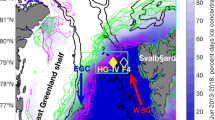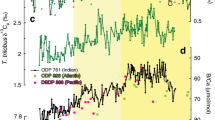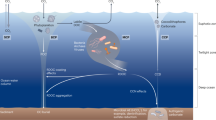Abstract
Arising from: W. R. Peltier, Y. Liu & J. W. Crowley Nature 450, 813–818 (2007)10.1038/nature06354; Peltier & Liu reply
The possibility that Earth witnessed episodes of global glaciation during the latest Precambrian challenges our understanding of the physical processes controlling the Earth’s climate. Peltier et al.1 suggest that a ‘hard snowball Earth’ state may have been prevented owing to the release of CO2 from the oxidation of dissolved organic carbon (DOC) in the ocean as the temperature decreased. Here we show that the model of Peltier et al. is not self-consistent as it implies large fluctuations of the ocean alkalinity content without providing any processes to account for it. Our findings suggest that the hard snowball Earth hypothesis is still valid.
Similar content being viewed by others
Main
Enhanced oxidation of a DOC reservoir at low temperature would drive the transfer of organic carbon into dissolved inorganic carbon (DIC), which would increase DIC as temperature declines, thereby increasing atmospheric CO2. Peltier et al. describe a closed carbon cycle and only account for processes occurring in the oceanic and atmospheric reservoirs, while neglecting continental weathering. However, their study spans several million years, a timescale over which this process is the dominant forcing function of climate evolution2,3,4,5. To keep the carbon model of Peltier et al. physically consistent, silicate weathering has to be accounted for, which would heavily affect atmospheric CO2.
The partial pressure of atmospheric CO2 ( ) is dependent on the DIC content of the ocean and on alkalinity. Peltier et al. assume that atmospheric carbon content is related to the DIC content of the ocean to the power X (X = 2 being the standard case; equation (2) in ref. 6). However, Kump and Arthur6 arrived at this mathematical expression by assuming that sea water was saturated with respect to the mineral calcite. Peltier et al. suggest that the ocean DIC content rose markedly in response to the oxidation of a DOC reservoir. Consequently, keeping the validity of the equation of Kump and Arthur implicitly requires that seawater alkalinity also rose drastically (to maintain the saturation with respect to carbonate minerals and to ensure the validity of the key equation of their model). Using equations defining seawater carbonate speciation, we calculated the concomitant change in alkalinity implied by Peltier et al. (Fig. 1a). We find that carbonate alkalinity has to rise by 40% when calculated atmospheric CO2 rises from 100 to 450 parts per million by volume (p.p.m.v). Values other than 2 for X are meaningless; X is not a free parameter and depends on the equilibrium constants of the carbonate speciation.
) is dependent on the DIC content of the ocean and on alkalinity. Peltier et al. assume that atmospheric carbon content is related to the DIC content of the ocean to the power X (X = 2 being the standard case; equation (2) in ref. 6). However, Kump and Arthur6 arrived at this mathematical expression by assuming that sea water was saturated with respect to the mineral calcite. Peltier et al. suggest that the ocean DIC content rose markedly in response to the oxidation of a DOC reservoir. Consequently, keeping the validity of the equation of Kump and Arthur implicitly requires that seawater alkalinity also rose drastically (to maintain the saturation with respect to carbonate minerals and to ensure the validity of the key equation of their model). Using equations defining seawater carbonate speciation, we calculated the concomitant change in alkalinity implied by Peltier et al. (Fig. 1a). We find that carbonate alkalinity has to rise by 40% when calculated atmospheric CO2 rises from 100 to 450 parts per million by volume (p.p.m.v). Values other than 2 for X are meaningless; X is not a free parameter and depends on the equilibrium constants of the carbonate speciation.
a, The increase in carbonate alkalinity concentration in sea water as a function of atmospheric partial pressure of CO2 ( ) required by the Peltier et al.1 scenario for snowball Earth prevention. It is expressed in percentage increase from the alkalinity content at 100 p.p.m.v. The green shading corresponds to calculations performed at 4 and 25 °C. We use equations defining seawater carbonate speciation when equilibrated with the atmospheric CO2 level. As boundary conditions, we use the oscillating
) required by the Peltier et al.1 scenario for snowball Earth prevention. It is expressed in percentage increase from the alkalinity content at 100 p.p.m.v. The green shading corresponds to calculations performed at 4 and 25 °C. We use equations defining seawater carbonate speciation when equilibrated with the atmospheric CO2 level. As boundary conditions, we use the oscillating  of the Peltier et al. study1 (between 100 and 450 p.p.m.v). b, Comparison between the atmospheric
of the Peltier et al. study1 (between 100 and 450 p.p.m.v). b, Comparison between the atmospheric  calculated by Peltier et al. (ref. 1; blue line) and the range of CO2 change required by the carbonate alkalinity fluctuations implied by the Peltier et al. model (grey shaded area; optima are represented by diamonds).
calculated by Peltier et al. (ref. 1; blue line) and the range of CO2 change required by the carbonate alkalinity fluctuations implied by the Peltier et al. model (grey shaded area; optima are represented by diamonds).
The additional alkalinity cannot come from either the dissolution of seafloor carbonates (because the model of Peltier et al. implicitly assumes permanent saturation of seawater with respect to calcite) or from the oxidation of DOC by oxygen (because this process does not supply alkalinity). Anoxic recycling of organic matter may provide alkalinity, but this process is overlooked by Peltier et al. This leaves continental weathering as the only remaining source of the additional alkalinity. The weathering of exposed carbonate platforms cannot be the culprit, as sea level also rises by several hundred metres in the model of Peltier et al. when CO2 increases from 100 to 450 p.p.m.v. Carbonate platforms should therefore be water-covered, and this source of alkalinity should actually decrease with rising CO2 (ref. 7). The ultimate source of alkalinity is continental silicate and intracratonic carbonate weathering which is a function of climate and atmospheric CO2.
Using the GEOCLIM numerical model describing continental weathering under Neoproterozoic conditions4, we calculated that the fluctuations in continental weathering implicitly required by Peltier et al. force the atmospheric CO2 to fluctuate between 320 and 800 p.p.m.v. (Fig. 1b), markedly above their CO2 reconstruction. The model of Peltier et al. arrives at a paradox. The equation that underpins their study requires that continental weathering changed markedly during their calculated carbon cycle oscillations, whereas Peltier et al. state that continental weathering is negligible because air temperature is low and land plants are absent in the Proterozoic. Our calculations indicate that overly simplistic descriptions of the geological carbon cycle can result in misinterpretations.
References
Peltier, W. R., Liu, Y. & Crowley, J. W. Snowball Earth prevention by dissolved organic carbon remineralization. Nature 450, 813–818 (2007)
Berner, R. A. & Caldeira, K. The need for mass balance and feedback in the geochemical carbon cycle. Geology 25, 955–956 (1997)
Donnadieu, Y. et al. A GEOCLIM simulation of climatic and biogeochemical consequences of Pangea breakup. Geochem. Geophys. Geosyst. 7 10.1029/2006GC001278 (2006)
Donnadieu, Y. et al. A ‘snowball Earth’ climate triggered by continental break-up through changes in runoff. Nature 428, 303–306 (2004)
Walker, J. C. G., Hays, P. B. & Kasting, J. F. A negative feedback mechanism for the long term stabilization of Earth’s surface temperature. J. Geophys. Res. 86, 9776–9782 (1981)
Kump, L. R. & Arthur, M. A. Interpreting carbon-isotope excursions: Carbonates and organic matter. Chem. Geol. 161, 181–198 (1999)
Ridgwell, A. J., Kennedy, M. J. & Caldeira, K. Carbonate deposition, climate stability, and Neoproterozoic ice ages. Science 302, 859–862 (2003)
Author information
Authors and Affiliations
PowerPoint slides
Rights and permissions
About this article
Cite this article
Goddéris, Y., Donnadieu, Y. Carbon cycling and snowball Earth. Nature 456, E8 (2008). https://doi.org/10.1038/nature07653
Received:
Accepted:
Issue Date:
DOI: https://doi.org/10.1038/nature07653
This article is cited by
-
A Review of the Neoproterozoic Global Glaciations and a Biotic Cause of Them
Earth Systems and Environment (2021)
-
The transition from the present-day climate to a modern Snowball Earth
Climate Dynamics (2010)
-
Peltier & Liu reply
Nature (2008)
Comments
By submitting a comment you agree to abide by our Terms and Community Guidelines. If you find something abusive or that does not comply with our terms or guidelines please flag it as inappropriate.




